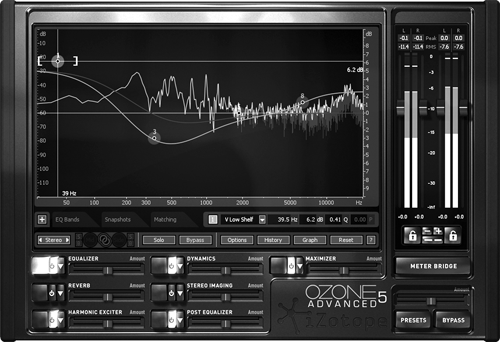IZOTOPE OZONE 5
While it may seem a bit unusual to process what are essentially live voiceover tracks with a multiband mastering plug-in, in reality it does make a certain amount of sense. This is especially the case since the mastering plug in question is iZotope’s Ozone 5, the latest incarnation of one the music biz’s best-loved processors. Ozone consists of the functions one expects to see in mastering: four band dynamics (compressor, gate, limiting, and expansion), two four-band paragraphic equalizers, and a Maximizer (which is really just a limiter on steroids), plus a reverb, harmonic exciter, stereo imaging controller, plus dither, all in one plug-in which combines access, routing and control for all the individual processing sections. Since what I am using in this instance is primarily the dynamics and EQ, we’ll focus on these.

However, we should take first things first. Ozone 5 runs on Windows XP Service Pack 2 or later, Windows x64, Vista, and Win 7. On the Mac it runs on OS X 10.5.8 or later, and on Intel-based Macs only. It is available in all the popular plug-in formats: Pro Tools 7.4+ (both RTAS and AudioSuite), VST and VST 3, MAS, Audio Unit, and DirectX are all supported. The list of compatible editors is long, and it likely runs on yours just fine. Keep in mind that this is a healthy processor, and depending on how you set it up it may put a strain on older systems. Still, it’s worth the cost in CPU cycles.
Offering a four-band approach to processing, Dynamics consists of analog models offering compression, limiting, gating and expansion. Compression can be hard or soft, and there’s an Automatic Gain Compensation system that makes it easier to evaluate the effects of compression without being misled by level differences. The metering includes histogram options as well as a Gain Reduction Trace meter, both of which give you a comprehensive look at what the Dynamics are doing over time.
Each of the four bands has its own set of controls, which can be viewed at the same time if you select the global view. Selecting the Band view and then using the four band buttons greatly simplifies the display and is easier to work with as a result. Gain and Mix settings may be switched to global or per-band mode, and there’s also a wet/dry mix control for setting up parallel compression. A Linked Bands mode allows changes to be made across all bands by adjusting the settings of one band. The metering also includes a Dynamic Curve view showing both the input and output signals on two axes. This is very clean compression, with little or no “character”, and you can apply significant amounts of compression before the processing becomes audible. Operation is as straightforward as it is for any multi-band processor, whereby one has to keep in mind that the processing is being done per band; one can always set the processing to be the same for all four bands, but where’s the fun in that? Being a multi-band compressor, it is also useful for problem-solving such as reducing the level of popping or sibilance on individual tracks.
The EQ module is equally as comprehensive. It will model both analog filters and linear-phase filters, with the flexibility to combine both types. Version 5 includes various filter shapes when in analog mode, which did not previously exist. These include flat (Butterworth), low- and high-pass, low- and high-pass “brick wall”, and vintage shelving filters, the latter being models of old and highly-prized Pultec EQs. Taken together there are eight filter bands that can be set to bell, high-pass, low-pass, or high or low shelf, along with a spectrum analyzer available to view the stereo signal in L/R or M/S modes.
In addition to its manual EQ facilities, Izotope’s EQ Match mode is also included, so that one audio signal can be equalized to match the spectrum of another (using up to 8,000 linear-phase filters for those of you keeping score at home). You can also use the analog-modeled filters in match mode, which I prefer for this task. The procedure is to capture a couple of audio snapshots from your source and reference audio files, then you click radio buttons to show which should be made to match which. Press the Match button and a matching curve is overlaid on the EQ display alongside the snapshot spectrum, but this display may be disabled to conserve CPU resources. The Matching EQ works alongside the conventional EQ so it is still possible to apply conventional EQ to the matched sound, and as with most match EQ plug-ins, you can adjust the degree of matching and apply smoothing to the matching curve. While it sounds terminally tweaky, Match is ideal for using voice tracks recorded at different times, or even on different microphones, sound more like they came from the same session, a situation which occurs far too often today.
Given the complexity of this plug, it’s a good thing that it comes with some 250 presets which cover its uses, soup to nuts. The documentation is equally comprehensive, and is available both as a PDF and also as an eBook.
Is Ozone 5 overkill for simple voiceover tracking and processing? Perhaps, but it contains best-of-breed examples of the processors we use most often, along with other useful tools like the Reverb (which is more than serviceable) and the Maximizer (which is far preferable to normalization in my opinion). Most importantly it is flexible beyond belief, and is working for me quite nicely on this particular weekend.
iZotope’s Ozone 5 carries a suggested list price of $249 USD, and is available online for something less than $200. A fully functional demo is available at www.izotope.com, and Steve sez check it out.
♦
